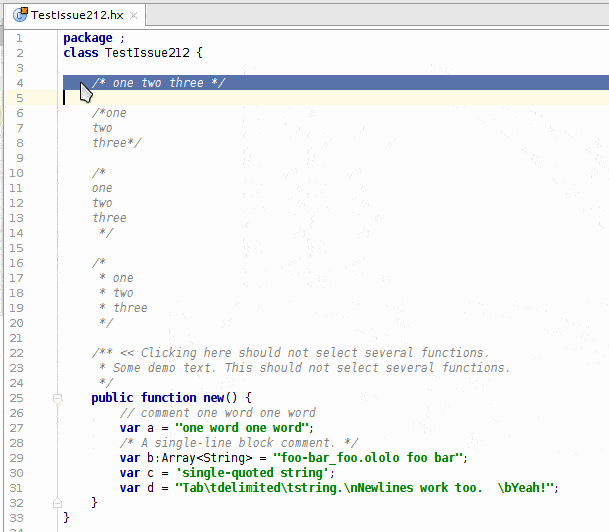Getting double-clicks to highlight what you want.
I’ve just spent a day and a half fixing bug #212, where the IntelliJ-Haxe plug-in doesn’t appropriately select words inside of string constants (a.k.a. characters enclosed in quotes: “This is a string.”). Before I fixed it, when you double-clicked on a string constant in the editor, it selected the entire string rather than the word you clicked on. Most programmers expect the word to be selected and get frustrated.
It turns out that while I was fixing the string handling that the comment handling was broken, too, as seen in this animation:

So, with a little experimentation and a little extra effort, I was able to correct both issues:

Hopefully, folks will find their double-clicking a bit more predictable.
How it’s done.
From here on in, this post gets quite technical, and is really targeted to plug-in authors. As such it assumes general knowledge of JetBrains’ plug-in architecture.
Now, JetBrains’ openapi, which IDEA uses extensively, has a default action for selection that handles a lot of general cases that are good enough for most programming languages. Selections are handled by an action handler, and we can override that just by providing an implementation and noting that in the plug-in’s xml descriptor file (we’ll get there in a minute). However, rewriting the entire action means that the original action selection handlers will no longer be available and/or we would have to duplicate a lot of code. There’s got to be a better way…
It turns out that the selection action itself uses pluggable “selectioners” to handle the actual selection process. (While I don’t like the name JetBrains chose, I guess it is easier to type than “SelectionProcessor,” “SelectionCreator,” “SelectionHandler” etc.) These are much easier to create and they don’t require rewriting the entire selection mechanism. Here is the API:
public interface ExtendWordSelectionHandler {
ExtensionPointName EP_NAME = ExtensionPointName.create("com.intellij.extendWordSelectionHandler");
boolean canSelect(PsiElement e);
List select(PsiElement e, CharSequence editorText, int cursorOffset, Editor editor);
}
The first member is the name of the extension point, which we will use in the plugin’s xml descriptor (src/META-INF/plugin.xml in our tree). The second member, the canSelect method, determines whether this handler can create a selection using given PSI element. The third member, select, actually calculates the selection.
When IDEA determines that it’s time to do a word selection, it goes down the list of *ALL* installed selection handlers. It calls each of their canSelect methods and remembers which of them had positive responses. Then, it calls the select method on each of those, and compares each of their results. The result with the smallest specific selection is kept. The code is in com.intellij.codeInsight.editorActions.SelectWordUtil.processElement(). Basically: (code paraphrased for clarity)
for (ExtendWordSelectionHandler selectioner : extendWordSelectionHandlers) {
if (selectioner.canSelect(element)) {
availableSelectioners.add(selectioner);
}
}
for (ExtendWordSelectionHandler selectioner : availableSelectioners) {
List ranges = selectioner.select(element, text, cursorOffset, editor);
for (TextRange range : ranges) {
if (minimumRange.get().contains(range)) {
minimumRange.set(range);
}
}
}
What this means is two-fold: It is up to the handler to decide whether it can work with the type, but it CANNOT guarantee that it is the only handler that will create a selection. Nor can it guarantee that its result will be the one used; the result competes with all others to be the most specific selection. If you want to fully control the selection process, you will have to override the editor action.
At any rate, you can see our solution in the github repository. As you can see, we first be sure that our Haxe-specific handler will not interfere with other languages:
public boolean canSelect(PsiElement e) {
return (e instanceof HaxePsiToken // <---- This line implies that it's a Haxe language token.
&& e.getLanguage().equals(HaxeLanguage.INSTANCE) // <---- This line ensures that another language hasn't subclassed our type.
&& HaxeTokenTypes.REGULAR_STRING_PART.equals(((HaxePsiToken)e).getTokenType())); // <---- And this one ensures that we're only working with strings.
}
Then we implement the actual selection algorithm. I don’t duplicate that code because it’s a bit lengthy, but you can find it here. It might be easier to look at it in the Pull Request. Then you’ll be able to see the code used to determine the bounds of the word.
At any rate, we are given the position of the cursor, the PSI element at that position, the (entire) text of the buffer in the editor, and a pointer to the editor window itself. From these, we start at the given position, get the text for the element, and walk backward and forward looking for word termination character. If the position is on a space and a word ends on the prior position, then we’ll select that word.
The last thing that we have to do is register the new handler. This is done in the plugin.xml file. We only had to specify the extension point name and the implementing class:
<extensions defaultExtensionNs="com.intellij">
[...]
<extendWordSelectionHandler implementation="com.intellij.plugins.haxe.editor.actions.wordSelection.HaxeStringSelectioner" />
[...]
</extensions>
Note that the entire name for the extension point as given in the API is com.intellij.extendWordSelectionHandler. However, the defaultExtensionNs does not have to be respecified on the actual implementation line. (However, if you place the directive in an extensions section that uses a different default, then you need to specify the whole string. I haven’t tried this, myself.)